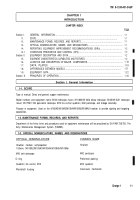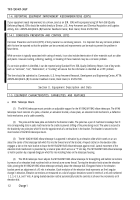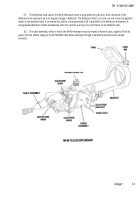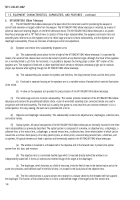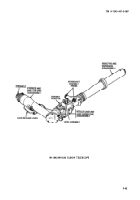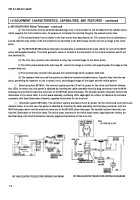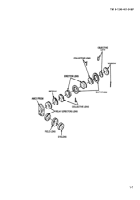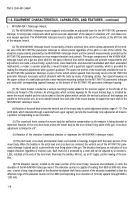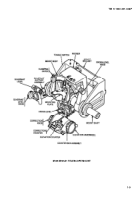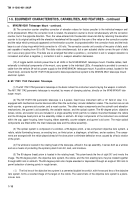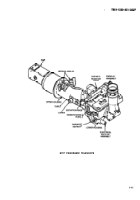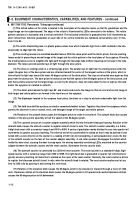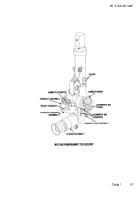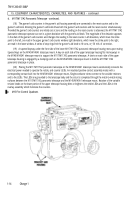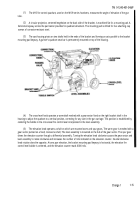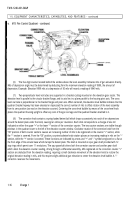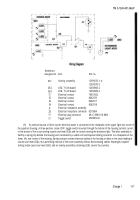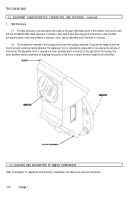TM-9-1240-401-34-P - Page 20 of 590
TM 9-1240-401-34&P
I
1-5. EQUIPMENT CHARACTERISTICS, CAPABILITIES, AND FEATURES - continued
I
c.
M145/M145A1 Telescope Mount - continued.
(9) The correction counter simplifies correction of elevation values for factors peculiar to the individual weapon and/
or its emplacement. When the correction knob is rotated, the elevation counter is driven simultaneously with the correction
counter, but in the opposite direction. Thus, the value entered into the elevation level vial disk by returning the elevation
counter to its original setting with the elevation handwheel will be equal to the sum of the value on the correction counter
and the value which previously appeared on the elevation counter. Incorporated within the correction knob and the knob
base is a set of stop rings which limits correction to +50 roils. The correction counter unit consists of two pairs of dials, each
pair capable of reading from 00 to 99. The dials rotate simultaneously, but a cam actuated shutter covers the pair of dials
not in use at any given time. The dials are so arranged that when a positive (+) correction is set in, weapon elevation is
increased, and when a negative (-) correction is set in, weapon elevation decreases.
(10) A toggle switch controls power flow to all LEDs in the M145/M145A1 telescope mount. Flexible cables, held
externally to individual components of the mount, carry power to the individual LEDs. A receptacle is provided to connect a
cable from the vehicle 24-volt dc power supply to the M145/M145A1 telescope mount. A positive contact, located in the
mount body, connects the M117/M117A2 panoramic telescope electrical system to the M145/M 45A1 telescope mount
electrical system.
d. Ml 17/M1 17A2 Panoramic Telescope.
(1) The M117/M117A2 panoramic telescope is the basic indirect fire instrument used in laying the weapon in azimuth.
The M117/M117A2 panoramic telescope is mounted, by means of clamping catches, directly on the M145/M145A1 tele-
scope mount.
(2) The M117/M117A2 panoramic telescope is a 4-power, fixed focus instrument with a 10° field of view. It is
equipped with mechanical counter devices rather than the customary circular deflection scales. The counters are an azi-
muth counter, a gunners aid counter, and a reset counter. The other major components are the azimuth and elevation
mechanisms, the gunner’s aid assembly, the variable resistor, and the optical system. The 90-degree prism, objective
lenses, reticle, and erector lens are included in a single assembly which permits no relative movement between the reticle
and the 90-degree head prism as the assembly rotates in azimuth. All major components of the instrument are contained
within the cap, upper housing, lower housing, elbow assembly, counter adapter, and gunner’s aid cover. The major opictal
components are fitted within the main telescope tube and the elbow assembly.
(3) The optical system is composed of a window, a 90-degree prism, a two-component objective lens system, a
reticle, reticle illuminating lenses, an erecting lens, an Amici prism, a diaphragm, a field lens, and an eyelens. The compo-
nents are arranged with the reticle placed ahead of the dove prism to eliminate deflection errors caused by off-axis rotation
of the prism.
(4) The window is located in the rotating head of the telescope, affixed in the cap assembly. It serves both as a window
and as a means of protecting the optical system from dirt, dust, and moisture.
(5) The 90-degree (head) prism is located in the rotating head. This prism bends the line of sight 90° and inverts the
image. The 90-degree prism, the objective lens system, the reticle, and the first erecting lens may be rotated together
through 6400 roils in azimuth. The 90-degree prism also maybe elevated or depressed through an angle of 300 roils to
permit selection of aiming points in rough terrain.
(6)
The first lens of the objective lens system is a cemented doublet lens which, with the second lens of the objective
lens system, forms a reverted image of the target on the reticle. The second lens of the objective lens system is a plano-
convex lens.
1-10
Back to Top


